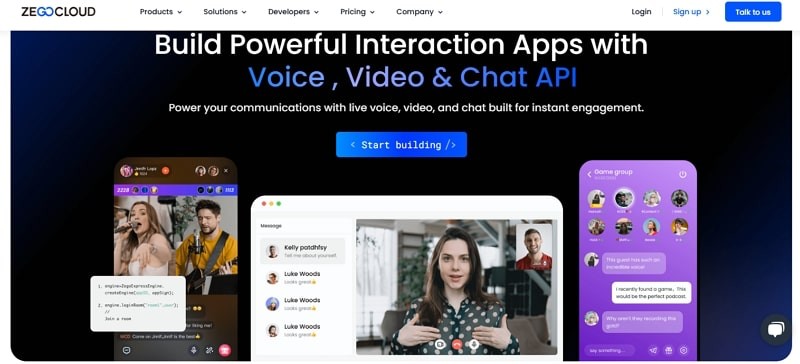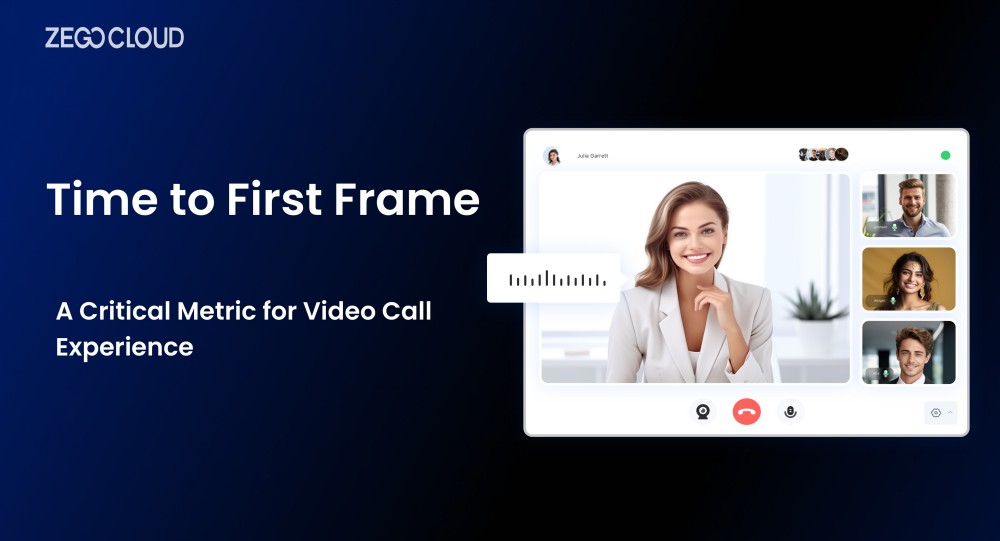In the realm of video conferencing and streaming, “Time to First Frame” (TTFF) holds immense significance as a crucial metric that gauges the user’s initial experience with video content. It represents the time elapsed between initiating a video call and the appearance of the first video frame on the screen. Users often perceive this metric as “latency,” which is pivotal in shaping their overall engagement and satisfaction.
What is Time to First Frame?
Time to First Frame (TTFF) is a crucial performance metric in real-time video communication. It measures the time from when a user initiates a video stream—such as joining a video call or live broadcast—to when the first video frame is displayed. A shorter TTFF leads to a smoother user experience, reduces dropout rates, and improves engagement. In high-demand scenarios like 1-on-1 calls or livestream shopping, optimizing TTFF is essential for retaining users and ensuring responsiveness. Platforms like ZEGOCLOUD optimize TTFF through intelligent routing and rapid media connection, achieving first-frame loading in under one second.
Importance of TTFF
TTFF has a profound impact on user experience in several ways:
- First Impression and Engagement: A quick TTFF creates a positive first impression, while a slow one may lead to frustration and abandonment. Users expect a seamless and immediate playback experience, and any delay in the appearance of the first frame can negatively affect their engagement.
- User Abandonment: Studies indicate viewers start abandoning online videos if they don’t load properly within 2 seconds. Users have limited patience when waiting for videos to load, and a prolonged TTFF may cause them to abandon the video altogether, leading to a loss of audience and potential revenue.
- Perceived Performance: TTFF is a vital determinant of the perceived performance of a video call. Users often equate slow loading times with poor overall performance, even if the subsequent playback is smooth. On the other hand, a quick TTFF can create the impression of high-quality and well-optimized content.
Why TTFF Should Be Under 2 Seconds?
Research has identified a critical threshold of two seconds for Time to First Frame (TTFF). If a video call takes longer than two seconds to begin playback, users are more likely to abandon the session. Each additional second of delay can result in an estimated 6% drop in viewer retention.
In real-time scenarios like 1-on-1 video calls or livestreaming, users expect near-instant feedback. Delays beyond two seconds often create a sense of system lag or connection failure, causing users to exit before the experience even begins. That’s why keeping TTFF under two seconds isn’t just a performance benchmark—it’s a business-critical metric.
Causes of Latency in TTFF
Time to First Frame (TTFF) is affected by multiple stages in the video transmission process. Each step introduces some degree of latency, which together determine how quickly the first frame appears on the user’s screen.
1. Capture
When the camera captures live video, it converts images into digital signals. This process causes a delay of at least one frame—around 1/30 of a second for a 30fps video.
2. Preprocessing
Video frames may be processed for noise reduction, image stabilization, and color correction. While these enhance visual quality, they also add latency.
3. Encoding
To prepare the video for online transmission, it is compressed using codecs like H.264. This step introduces latency, depending on encoder efficiency and settings.
4. Transmission
The encoded stream is sent to a video distribution system (VDS). Latency here is influenced by media bitrate, internet quality, and the physical distance to the server.
5. Jitter Buffering
To compensate for network fluctuations, the system temporarily buffers incoming packets. This improves playback stability but adds a small delay.
6. Decoding
The receiving device must decompress the video stream. The speed of this step depends on the device’s processing power and decoder optimization.
7. Post-processing
Additional effects or video enhancements may be applied before display, contributing slightly more latency.
8. Rendering
The final step is rendering the video on screen. The performance of the device and rendering engine can impact how quickly the first frame is displayed.
How to Improve Time to First Frame (TTFF) in Real-Time Video
IIn real-time audio and video communication, achieving “instant TTFF” relies on a combination of engineering optimizations and technical implementations:
1. DNS Resolution Optimization
For players based on FFmpeg, DNS resolution is handled using the getaddrinfo method. This approach accelerates domain name resolution and helps improve video playback speed.
2. Video Encoding Techniques
Using H.264 encoding and Group of Pictures (GOP) technology simplifies second-level loading. By starting transmission from the I-frame of the latest GOP, the receiver can quickly decode and display the first complete image.
3. End-to-End Latency Reduction
Reducing latency across the entire transmission path is key. Most delays occur at the network layer—from the user’s device to the server. Maintaining end-to-end latency under one second is crucial for a smooth experience.
4. Full-Link Optimization
End-to-end on-demand playback involves the entire video delivery chain—from upload SDK and video processing to CDN distribution and the playback SDK. Technical optimizations across these modules help achieve a near-instant first frame display.
5. Real-Time Computing and Data Processing
This involves real-time data collection and fast computation, often requiring sub-second response times. Combining open-source platforms with custom SDKs and processing frameworks enables efficient real-time handling.
6. Transmission Mechanism Optimization
To achieve a TTFF under 400ms in real-time video calls or live streaming, it’s essential to fine-tune the transmission mechanism. Optimizing media transport ensures ultra-low latency and fast visual response.
How ZEGOCLOUD Reduces TTFF in Real-Time Video Calls
ZEGOCLOUD has continuously optimized its end-to-end media pipeline to minimize Time to First Frame (TTFF) and deliver high-quality real-time communication experiences. Through years of technical refinement, ZEGOCLOUD has achieved millisecond-level TTFF in 90% of global video call scenarios.

Here’s how ZEGOCLOUD addresses latency at each stage:
- Capture & Rendering
ZEGOCLOUD applies bilinear downsampling techniques to maintain clarity while reducing the amount of data processed. This speeds up both encoding and rendering without compromising quality. - Preprocessing
Audio and video preprocessing includes advanced echo cancellation, noise suppression, and low-light enhancement. These algorithms are optimized for real-time efficiency, reducing pre-encoding delays. - Encoding & Decoding
Using its proprietary Z264 codec, ZEGOCLOUD enables high-quality video at lower bitrates, reducing transmission size and speeding up decode times across devices. - Transmission
A custom-designed transport protocol ensures precise packet delivery and adaptive congestion control, improving overall transmission speed and reliability. - Jitter Buffer Optimization
ZEGOCLOUD uses Time Scale Modification (TSM) to adjust playback dynamically, striking the right balance between smoothness and low latency. - Post-processing
Final-stage audio and video enhancements are performed using lightweight, high-performance algorithms to ensure a polished experience with minimal additional delay.
Thanks to these system-level optimizations, ZEGOCLOUD consistently delivers fast, smooth, and reliable first-frame performance—essential for modern real-time applications.
Conclusion
Time to First Frame is a critical metric that significantly impacts user satisfaction and engagement in video calls. By implementing strategies to minimize TTFF, app owners can create a seamless, immersive video experience that fosters user loyalty and drives business success. ZEGOCLOUD’s proven expertise in latency reduction provides a compelling solution for developers seeking to deliver exceptional video call experiences.
Read more:
Let’s Build APP Together
Start building with real-time video, voice & chat SDK for apps today!










